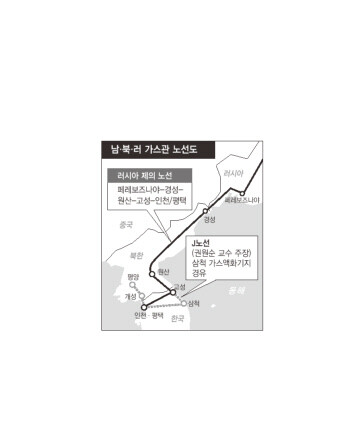hankyoreh
Links to other country sites 다른 나라 사이트 링크
Russia proposes gas pipeline route through N.Korea’s east coast

By Son Won-je, Staff Writer
It emerged on Tuesday that Russia has suggested a route for the gas pipeline that will connect it to South Korea via North Korea. The proposal would have a pipeline run through North Korea’s Gyeongseong and Wonsan, then on to South Korea’s Goseong, Incheon and Pyeongtaek.
Delivering a paper at the 43rd seminar of a forum on North Korean economics on Tuesday morning at the Lotte Hotel in Seoul’s Sogong neighborhood, Kwon Won-soon, professor of economics at Hankuk University of Foreign Studies and an expert on economic cooperation between South Korea and Russia, revealed that Russia’s Gazprom had recently suggested to KOGAS (Korea Gas Corporation) installing the pipeline along North Korea’s east coast railway line. The Gyeongseong-Wonsan-Goseong-Incheon route would pass along three railway sectors in North Korea: the Hambuk Line (Gyeongseong-Wonsan), the Pyeongna Line (Najin-Wonsan) and the Geumgangsan Cheongnyeon Line (Wonsan-Goseong), before continuing to South Korea’s metropolitan region along the Gyeongwon Line (Seoul-Wonsan).
“Building a pipeline along a railway line is the most economic and efficient method,” said Ahn Byeong-min, head of the Center for Northeast Asia and North Korea Transport Studies at the Korea Transport Institute. “It appears that North Korea has also agreed to the pipeline crossing these areas.”
A government official also said, “To my knowledge, Russia has already finished taking satellite photographs of these areas.”
Regarding the route for the pipeline within South Korea, however, Kwon claimed, “A J-shaped route that first went down to Samcheok and then came back up again would be preferable to one that went straight from Goseong to Incheon and Pyeongtaek. This would enable the exporting of gas to Japan, using the gas liquefaction terminal at Samcheok.”
Kwon flatly dismissed the possible theft of gas or blowing up of the pipeline by North Korea that some had mentioned, saying, “North Korea has no gas pipe network, so it would have nowhere to store gas even if it siphoned it off secretly, and blowing up the pipeline would clearly cause a large fire along the entire east coast.”
Kwon estimated the total cost of installing the pipeline to be $2.2 billion, and the annual fee for passing through North Korea to be $118.4 million. He also stated that the cost of sending gas through the pipeline to be no more than one third of the cost of sending liquid natural gas by ship.
Please direct questions or comments to [englishhani@hani.co.kr]
Editorial・opinion
![[Column] Has Korea, too, crossed the Rubicon on China? [Column] Has Korea, too, crossed the Rubicon on China?](https://flexible.img.hani.co.kr/flexible/normal/500/300/imgdb/original/2024/0419/9317135153409185.jpg) [Column] Has Korea, too, crossed the Rubicon on China?
[Column] Has Korea, too, crossed the Rubicon on China?![[Correspondent’s column] In Japan’s alliance with US, echoes of its past alliances with UK [Correspondent’s column] In Japan’s alliance with US, echoes of its past alliances with UK](https://flexible.img.hani.co.kr/flexible/normal/500/300/imgdb/original/2024/0419/2317135166563519.jpg) [Correspondent’s column] In Japan’s alliance with US, echoes of its past alliances with UK
[Correspondent’s column] In Japan’s alliance with US, echoes of its past alliances with UK- [Editorial] Does Yoon think the Korean public is wrong?
- [Editorial] As it bolsters its alliance with US, Japan must be accountable for past
- [Guest essay] Amending the Constitution is Yoon’s key to leaving office in public’s good graces
- [Editorial] 10 years on, lessons of Sewol tragedy must never be forgotten
- [Column] A death blow to Korea’s prosecutor politics
- [Correspondent’s column] The US and the end of Japanese pacifism
- [Guest essay] How Korea turned its trainee doctors into monsters
- [Guest essay] As someone who helped forge Seoul-Moscow ties, their status today troubles me
Most viewed articles
- 1[Column] The clock is ticking for Korea’s first lady
- 2Hong Se-hwa, voice for tolerance whose memoir of exile touched a chord, dies at 76
- 3After 2 months of delayed, denied medical care, Koreans worry worst may be yet to come
- 4[Column] Has Korea, too, crossed the Rubicon on China?
- 5US overtakes China as Korea’s top export market, prompting trade sanction jitters
- 6[Correspondent’s column] In Japan’s alliance with US, echoes of its past alliances with UK
- 7All eyes on Xiaomi after it pulls off EV that Apple couldn’t
- 8Samsung barricades office as unionized workers strike for better conditions
- 9[Photo] Smile ambassador, you’re on camera
- 10[Correspondent’s column] The US and the end of Japanese pacifism